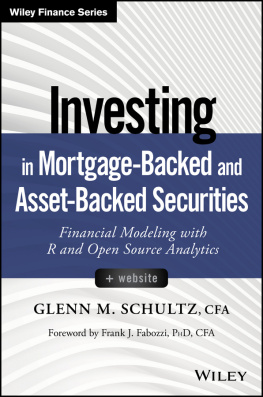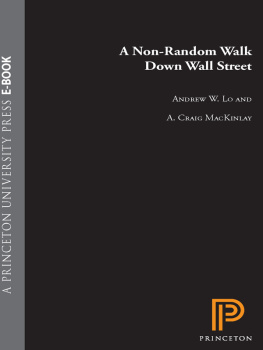COWLES FOUNDATION
for Research in Economics at Yale University
MONOGRAPH 16
COWLES FOUNDATION
For Research in Economics at Yale University
The Cowles Foundation for Research in Economics at Yale University, established as an activity of the Department of Economics in 1955, has as its purpose the conduct and encouragement of research in economics, finance, commerce, industry, and technology, including problems of the organization of these activities. The Cowles Foundation seeks to foster the development of logical, mathematical, and statistical methods of analysis for application in economics and related social sciences. The professional research staff are, as a rule, faculty members with appointments and teaching responsibilities in the Department of Economics and other departments.
The Cowles Foundation continues the work of the Cowles Commission for Research in Economics founded in 1932 by Alfred Cowles at Colorado Springs, Colorado. The Commission moved to Chicago in 1939 and was affiliated with the University of Chicago until 1955. In 1955 the professional research staff of the Commission accepted appointments at Yale and, along with other members of the Yale Department of Economics, formed the research staff of the newly established Cowles Foundation.
A list of Cowles Foundation Monographs appears at the end of this volume.
Portfolio Selection
EFFICIENT DIVERSIFICATION OF INVESTMENTS
Harry M. Markowitz
NEW HAVEN AND LONDON, YALE UNIVERSITY PRESS
Copyright1959 by Cowles Foundation for Research in
Economics at Yale University.
Second printing, 1970.
Originally published by John Wiley & Sons, Inc.
All rights reserved. This book may not be
reproduced, in whole or in part, in any form
(except by reviewers for the public press),
without written permission from the publishers.
International standard book number: 0-300-01369-8 (cloth),
0-300-01372-8 (paper)
To Mildred and Morris
CONTENTS
PREFACE TO THE SECOND PRINTING
The correction of a number of errors originally missed in proofreading and the addition of a new bibliography differentiate this printing from the first.
Most of the errors were discovered while this book was being translated into Japanese by Professor Suzuki of Tokyo University, under the auspices of the Yamaichi Investment Trust Management Co., Ltd. I am greatly indebted to Professor Suzuki for these corrections, and to Tatsuo Majima, President, and Kazuo Kitamura, Director and Manager of the Research Department of Yamaichi, with whom I corresponded concerning the arrangements for, and the progress of, the translation.
The new bibliography (pp. 30815) was graciously supplied by Mark Rubinstein. It was drawn from a larger bibliography of his which is to appear elsewhere. Rubinsteins annotated condensed bibliography is included here to provide the reader with an introduction to the extensive recent literature on portfolio selection.
This literature includes works which apply the Expected return. Variance of return (E, V) efficient set analysis to areas beyond those covered in this book, and works which attack or defend the E, V efficient set approach. A brief characterization of what, to my mind, has been the impact of this literature on the contents of this book may be of interest to some readers. I will not try to argue my present positions here but will merely state them. Not all contributions of substantial significance are even mentioned in this thumbnail sketch. My comments are organized according to the chapters of the book.
applies when utility of terminal wealth is bounded).
Be this as it may, the reader should not lose sight of the illustration in .
, I illustrate a variety of concrete portfolio requirements which can be handled as special cases of the general constraints Ax = b, x 0 (matrix notation). The proper treatment of the short sale case is included.
Much of the interest in, and experimentation with, portfolio analysis in the 1960s was stimulated by the publication of Sharpes article and the availability of his single-index, FORTRAN, portfolio selection program.
presents the geometric analysis and computing procedures if semi-variance is substituted for variance in the efficient set analysis. The algorithm is more costly but not prohibitive. While semi-variance has adherents in principle, no computer code has been produced as yet.
discusses additional conditions sufficient for the relatively inexpensive E, V efficient set analysis to give at least near-optimum results.
The most discussed theoretical objections to the E, V efficient set analysis ). My own chief concern lies elsewhere.
(1) My view of the expected utility maxim is the same as when I wrote . Parenthetically, I know of no plausible axiom system implying probability beliefs that does not also imply expected utility.
(2) Regarding the Mandelbrot-Fama contention that variance is infinite: (a) I am willing to assume that all my subjective distributions of return are boundede.g. between 100 percent loss and a trillion percent gainand therefore have all their moments. (b) The strange conclusion that variance is infinite is derived by starting with the assumption that the probability distribution of hour-to-hour fluctuations in security prices has the same form as, say, that of month-to-month fluctuations, which in turn has the same form as, say, the probability distribution of year-to-year fluctuations. This assumption seems less than certain when we contrast the business determinants of the year-to-year fortunes of an enterprise with the market determinants of the hour-to-hour fluctuations in its stock. The assumption becomes even more questionable when we learn that the assumption implies a priori that either the distribution is normal or it has infinite varianceexcluding not only all bounded distributions, but also most of the familiar unbounded distributions such as 2 and Student. Having assumed this much, the next step is to infer empirically that since the distribution is not precisely normal, it must have infinite variance.
(3) In light of the results of Pratt-Schlaifer and Borch regarding quadratic utility functions, the argument concerning quadratic approximation (in , it repeatedly turns out that method (b) does better than (a). It now further turns out that method (a) is subject to the Pratt-Schlaifer and Borch objections, while method (b) is not. Thusuntil some still better method presents itself for estimating expected utility from the E and V of realistic distributionsthe use of the method of quadratic approximation, in theory and practice, should be confined to method (b) with X0 = E.
My own chief theoretical worry remains, as in simulation analyses of portfolio adjustment procedures are important steps in the right directions, but this critical area remains mostly unexplored.
As noted above, this brief sketch of my current general position does not attempt to mention every important recent contribution to portfolio theory and its application in practice.
H.M.M.
Beverly Hills, California
August, 1970
PREFACE
This monograph presents techniques for the analysis of portfolios of securities. Although the techniques are mathematical in nature, the monograph is written primarily with the non-mathematician in mind. , finally, discusses the theory of rational behavior and its applications to the selection of portfolios.
The appendices of the book are for the mathematically trained reader only. Their main function is to prove certain more advanced relationships noted and used in the text.
The mathematically trained reader may find the following suggestions helpful: present certain laws of large numbers.)
Next page







